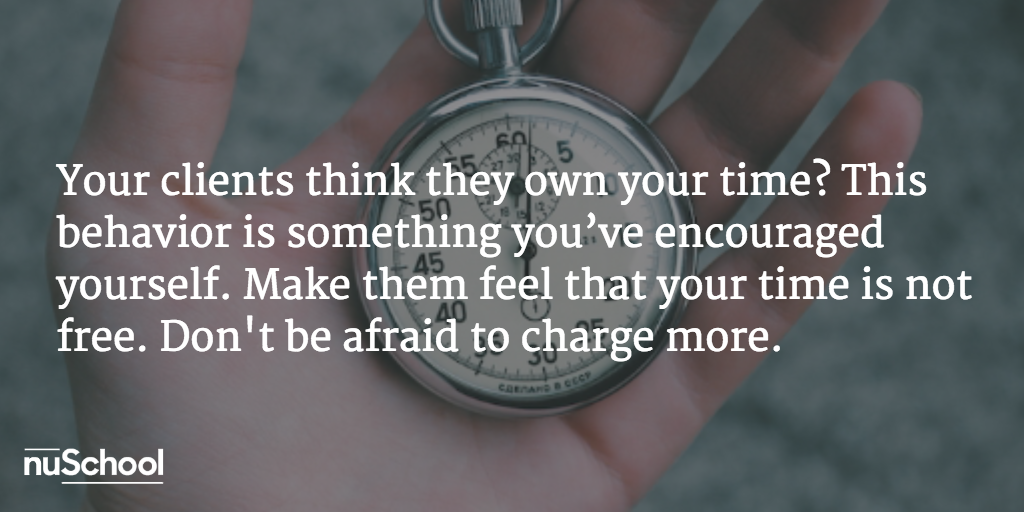Save Yourself From Endless Client Requests
[This post is now updated with even more tips and a slideshow]
– “There’s one more thing I need you to do…”
– “Can we add those last few things to the design before we publish?”
– “I had a dream last night. We need to re-do everything!”
There’s nothing I hate more than hearing my clients saying those sentences. Innocent client requests which can easily turn into never-ending modification requests. So I learned how to save myself from this horror. Bear with me for three minutes, and you could save yourself too.
Oh, there’s a bonus – you can even learn how to turn those into more money.
Paid changes vs. Endless non-paid requests
During the project, there’s a reasonable amount of changes that we’re doing for the client. Preferably we’ve agreed on a number of iterations of design changes. Those iterations should appear in the contract, and the client is paying for them.
But then what happens more often than not, is that your client keeps on asking you to change things long after those iterations are over. For how long? Well, for some clients this behavior lasts forever. That long.
Those are requests for non-paid changes. Meaning, if you’re working on those, you’re working for free. Or in other words – you’re losing money.
Why Do Your Clients Want Endless Changes, and how to stop it?
There are a few common reasons for why it happens. If you remain guarded you can stop this behavior before it turns into a habit.
Your client has no clue
A few months ago I worked on a website for a 60+ lady, who runs a cooking class and wanted me to create a nice website to promote her business. She knew exactly what she needs for her website, so when we talked, the job was already detailed and clear. She has never built a website before, and I was really happy that she knows what she wants, so I can start the work immediately.
The thing is, she’s not a designer, or a developer. More than that – she’s 60+ and doesn’t have a Facebook account. Now when her granddaughter saw the website ready two months later, she asked her – “granny, where are all the Facebook share buttons?”. Oops! We forgot about that. And I say “we” because how would this woman know about those buttons? She doesn’t even have a Facebook profile. It must be my fault as well.
Now she is frustrated. “Every website has Facebook share buttons these days! It’s so basic!” she tells me, quoting her granddaughter. “Well, you should have thought about it before I finished working on your website!”, I think to myself. “It’s not my fault!”, I feel like screaming. But, I also want to make her happy, and let’s face it – this is indeed a basic feature.
Be a consultant not just a designer
You see, for some of your clients, this is their first time doing such a project. Therefore a common reason why they keep asking you to change things forever, or adding new requests, is because they are clueless what to ask you to begin with. So long after you’ve finished your work they discover new things they wish they knew about before.
Such circumstances could be avoided 90% of the time. Don’t let your oblivious clients decide on the requirements themselves. Take responsibility that you know more than they do, and as early as possible into the project (or even before it started), let them know what they’ve missed. Sit down, take a good look at the job, and think.
And this goes for things much more complicated than FB share buttons. In web design, it could be this error-message-popup when users login fails, or in graphic design, it could be that A3 cards your client forgot to ask for, that he needs for the opening night of the restaurant.
Acting this way, your client will see you,not just as a creative professional, but as a consultant. He will feel you’re an authority, and later on, when you argue about professional stuff, you’ll have the upper hand.
He thinks he owns your time
Some clients think that if they hired you to do some work, they now own you for 24/7. They are not afraid to ask for changes and additional requests you’ve never discussed in the first place. They assume you have nothing in your life other than working for them, hence, they expect you to make any changes they ask for.
Again, that’s fair within the accepted amount of iterations, but unfair when those are over.
You know what? Sometimes this behaviour is something you’ve encouraged yourself.
It usually starts early in the project as you try to build rapport with your client. He asks you for a small change, and you immediately reply “with pleasure”. At this point you give him the feeling that you are his true partner. He’s happy about that, telling himself he made the right choice taking you for this job. Good for you.
But, on the long term, this can make you very miserable. You’re not really his partner, it is his business, and he pays for a definite expanse of your time to help him with it. If you keep on doing this, the project will take much longer than you expected, and you’ll get paid less than you should.
Moreover, when you realized that you “had enough” with the change requests, your client might be surprised. Because he thought you’re partners. Now it turns out as if YOU are the villain. Not him!
Don’t let him think your time is free
Here is how I stop this from happening. When a client asks me to change/add/remove something, I remind him that I do it within our agreed iterations. But when those are over and I shouldn’t do more changes for free, I reply with: “Cool! I think that’s a great idea! Now let’s think together what we give up on, so I can have the time to make that change for you.”
By saying that, I show my client that I’m open for changes. But at the same time, my time is not free. If he wants to use my time differently than the original plan, that’s fine. But I’m not going to do more work on my expense.
Your client might not react well to this, but he’ll quickly get used to it. A few of my clients are so used to it, that when they call me asking for modification, they already did some thinking about what they’re willing to give up on instead.
Actually, I start it even earlier, during the negotiation on the pricing and terms of the project. If the client asks me to lower my price in the proposal, I always agree. But with one condition – that we take some requirements away. Educate them how to respect your time, it is only fair.
When life gives you lemons…
When I started educating my clients that my time is not for free, I observed that they never really want to give up on anything we agreed before. They just want to add more and more features to their projects.
This is how I came up with the “Phase Two” method.
When my client asks me to do Y (which wasn’t included in the original agreement), I offer him to do it, but giving up on of doing X. I never tell him “let’s throw X to the bin”. Instead, I offer him to delay X for a Phase Two of the project. We can’t do X now, because he wants to do Y instead, and it will delay the deadline of the project. But if X is still important, we can do it later, right after we finish Phase One.
See what I just did? I created myself more work, and my client is happy, because I’m not ignoring his will. “Phase Two” is my way to start working on additional stuff for this client, without touching the contract, or the scope of work, or the payments of the current project. I write down a “Phase Two” list, share it with my client, and we manage it together.
Here’s your lemonade!
You can and should avoid endless change requests
To sum it up, here’s what you should do:
1. Help your client not to miss important things in the first place. Be his consultant and he’ll respect you even more.
2. Educate your clients that your time is not free. You are willing to make changes during the project, but it means that other things define on your contract won’t happen. Start doing it as soon as the first change request arrives.
3. Gather less-urgent requirements with your client on a “Phase Two” list. Create yourself more work, and make him feel he will have the perfect product he wanted by simply hiring you.
Super!
Good stuff is on the way.
Oops! Something went wrong while submitting the form :(





